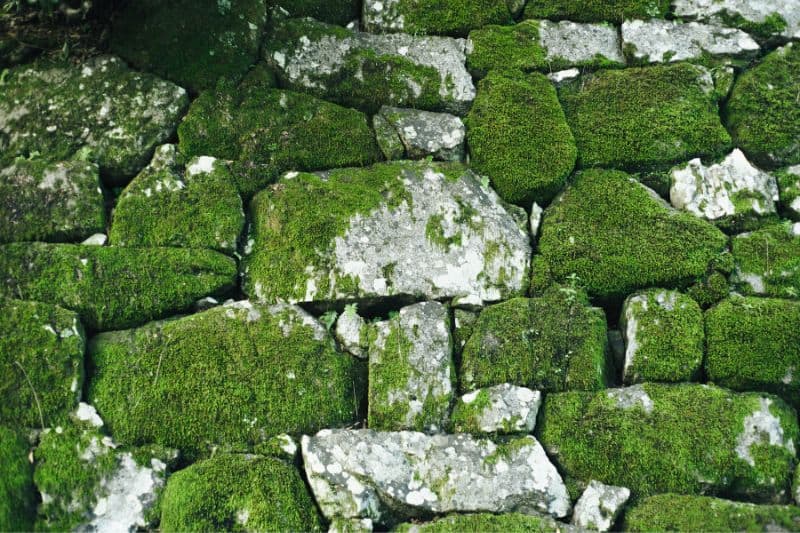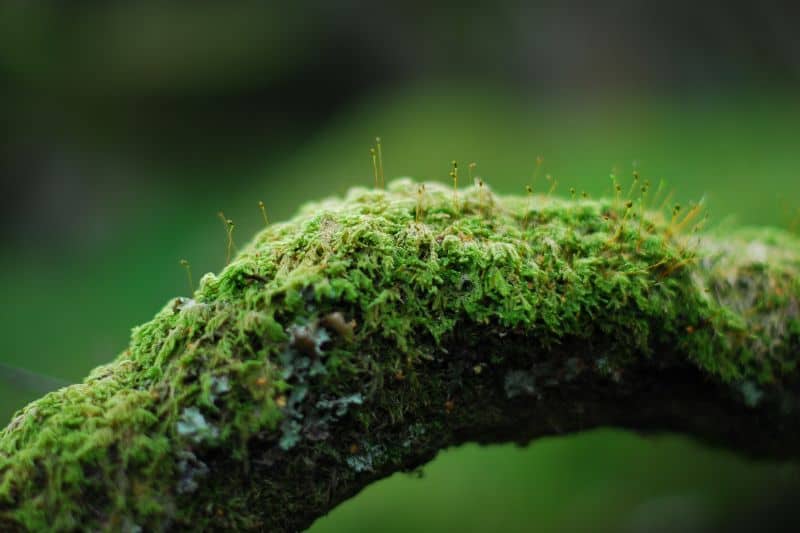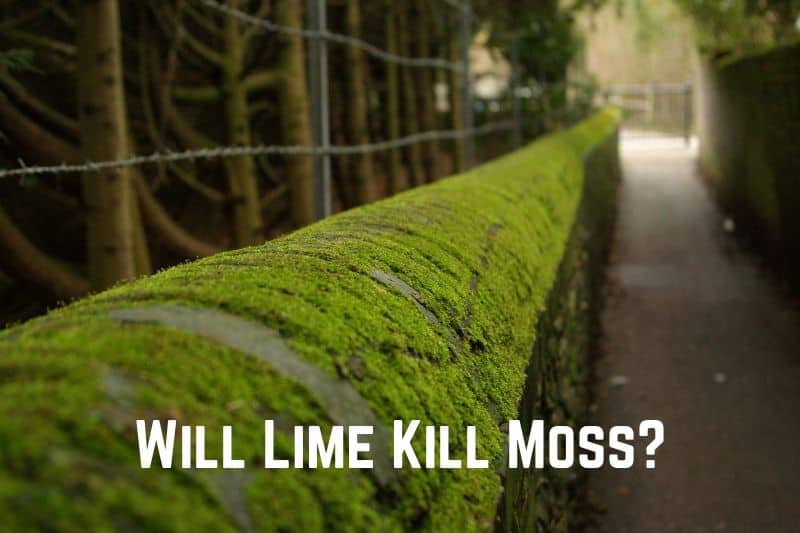Mosses are always a nightmare for every home gardener. Even though hard you scrap away the moss growth, within a few days, they will strike again. This thick, sponge-like green vegetation providing a natural ground cover is attractive yet persistent. Invading your lawn and any free moist soil in the garden, they can replace your beautiful turf grass in days!!
Getting rid of the moss completely is a work of patience. However, they establish and spread quickly and getting them disposed of needs a lot of time. And the real question is: Will lime kill moss? Let’s look into it and get an answer to our question.
Starting with Moss
Characteristics of Moss
Moss is a small, green, non-vascular plant that grows in damp, shady environments. It doesn’t have true roots. Instead, it possesses a network of tiny filaments called rhizoids which help anchor it to surfaces. There are over 12,000 known species of moss, so you are likely to encounter it quite often.
Moss plays a vital role in its ecosystem by:
- Helping to prevent soil erosion
- Retaining moisture in the soil
- Providing shelter for small insects and other organisms
Understanding Moss Growth
Moss thrives in moist, shady areas with high humidity. It can grow on surfaces like soil, rocks, tree trunks, and even bricks. To grow, moss relies on its ability to absorb water and nutrients through its leaf surface. It reproduces either through spores or by fragmentation.
However, not all moss is beneficial, and sometimes you might need to remove it from your property. If moss invades your lawn, walkways, or rooftops, it can cause damage or be a safety hazard. In such cases, using a moss killer, like lime, can help you maintain the appearance and function of your outdoor environment.
Let’s explore how to use lime effectively to kill and prevent moss:
Does Lime Kill Moss?
Lime is an alkaline substance that raises the soil’s pH level, making it less friendly for moss growth. Lime may not directly kill moss, but it helps create an environment that prevents its growth in certain conditions. In other words, you can use lime to kill moss but it will take a good amount of time.
Moss tends to grow in areas with acidic soil, poor drainage, and shade. Raising your soil’s pH makes it less acidic, creating an environment where moss struggles to thrive.
To do this, you can apply lime to your lawn or garden. But first, test your soil’s pH level with a soil test kit. Your soil should have a pH of 6.0 to 7.0 for healthy grass growth. If your soil’s pH is lower than 6.0, then it’s acidic and lime can help control the moss.
When applying lime, follow the product’s label instructions and spread it evenly on your lawn. Remember that you may need to reapply the lime several times throughout the year to maintain an alkaline environment.
In addition, don’t forget to address other factors that encourage moss growth. Make sure your lawn has proper drainage, remove thatch or dead grass, and prune or trim trees to allow sunlight into the area where moss is growing.
By combining lime treatment with simple gardening practices, you can effectively control and prevent moss from taking over your lawn.
Will Hydrated Lime Kill Moss?
Hydrated lime (i.e. Calcium hydroxide) is also not a moss killer too. Just like regular lime, they increase the soil pH to alkaline and create conditions unfavorable for moss. But it is very well to know mosses are great fighters and sure they will manage their way forward adapting to the new soil pH.
The common turf grass loses its density and starts to disappear when the soil pH turns acidic. This paves the way for the growth and establishment of moss populations. The addition of the required amount of hydrated lime can resolve this issue.

What Kills Moss Naturally?
Moss is a small, nuisance plant that can grow on various surfaces like sidewalks, roofs, and lawns. It’s understandable that you’d want to get rid of it without causing harm to the environment or other plants. There are several natural remedies you can use to eliminate moss effectively.
Vinegar is a popular choice for killing moss naturally. Mix equal parts water and white vinegar in a spray bottle, and apply it directly to the mossy areas. Be cautious as vinegar can also harm other plants if it comes in contact with them.
Baking soda is another environmentally friendly option to remove moss. You can sprinkle it over the moss and then gently scrub away the dead plant material with a brush. Ensure you don’t use excess baking soda, as it can change soil pH, impacting other plants.
A moss rake or a scrub brush can be used to physically remove the moss. Raking up or scrubbing off the moss can help promote airflow and expose the area to more sunlight, discouraging it from growing back.
Increasing sunlight exposure in the affected area can also prevent moss from taking over. Pruning nearby trees and removing any debris that may be shading the area will help prevent moss growth.
Lastly, consider improving your drainage system or addressing any issues that lead to excess moisture. Moss thrives in damp, poorly drained areas, so keeping your lawn healthy and well-drained will discourage its growth.
Using these natural remedies, you can effectively eliminate and prevent moss from overtaking your outdoor areas in a friendly and eco-conscious manner.
Why Does My Lawn Have Moss?
Moss can start growing in your lawn for a variety of reasons. It’s essential to understand the factors that contribute to its growth so you can properly address them. Here are a few of the main causes that might lead to moss thriving in your yard.
Poor soil quality is one factor that can encourage moss growth. When your lawn’s soil is compacted, acidic, or poorly drained, it creates an environment where grass struggles to grow and moss thrives. To resolve this issue, you might want to aerate your lawn, amend the soil with compost, or correct the pH levels.
Another reason moss might be growing in your lawn is due to excessive shade. Grass needs sunlight to grow strong and healthy, while moss can thrive in shady, damp areas.
If the moss is growing in a particularly shady spot, consider trimming back any tree branches or bushes that are casting heavy shade. Alternatively, you may decide to embrace the shade and plant grass species that are more shade-tolerant.
Inadequate lawn care practices can also contribute to the growth of moss. Try adjusting your mowing and watering routines. Mowing your lawn too short can leave grass weak and susceptible to moss invasion, so try raising your mower blades to maintain a slightly higher grass height.
Overwatering your lawn can cause it to be consistently damp, making it ideal for moss. Practice proper watering habits by giving your lawn a deep soak once or twice a week, allowing the water to penetrate the soil and encourage deeper root growth.
Finally, moss often grows in lawns that are nutrient-deficient. This can be a result of poor soil quality or the neglect of regular fertilization. Ensuring that your lawn receives the appropriate nutrients will encourage healthy grass growth and make it more challenging for moss to establish itself.
Natural Ways to Get Rid of Moss in Your Lawn
Moss in your lawn can be unsightly and prevent grass from growing properly. While lime can be an effective solution, there are other natural ways to eliminate moss. Here are a few suggestions to help keep your lawn happy and healthy.
Improve Drainage: Poor drainage often leads to excess moisture and moss growth. You can aerate your lawn by poking holes in the soil using a garden fork or a lawn aerator. This will improve the flow of air, water, and nutrients to the grassroots, making it harder for moss to thrive.
Increase Sunlight: Moss thrives in shaded areas. By trimming back overhanging trees and shrubs, you can ensure your lawn receives the right amount of sunlight, eliminating one of the main conditions that make moss grow. Remember to keep an eye out for new moss growth in the shaded areas of your lawn.
Maintain Soil pH: Another key to keeping moss at bay is maintaining a healthy soil pH between 6.0 and 7.0. You can test your soil pH using a simple kit from a garden center. If your soil pH is too low, apply a slow-release fertilizer to help increase the pH levels.
Regular Lawn Maintenance: Regular lawn care is one of the best ways to prevent moss growth. Mowing your lawn at the proper height, watering it evenly, and fertilizing it throughout the year will help maintain optimal grass growth, making it less likely for moss to invade. Remove any fallen leaves and debris to prevent any exciting moss from spreading.
By following these natural methods, you can reduce and eliminate moss growth in your lawn without the use of chemicals. With consistent care and attention, you’ll be able to maintain a beautiful, moss-free lawn.

How to Apply Lime to Kill Moss?
Ideal Time for Application
The best time to apply lime to kill moss in your lawn is during the fall or spring, when the temperatures are mild and the ground is moist. This allows the lime to penetrate the soil more effectively and deliver the desired results. It’s recommended to test your soil’s pH levels before application to determine the proper amount of lime needed to balance the acidity.
Proper Method of Application
Before you begin, make sure you have protective gear such as gloves and a dust mask, as lime can be irritating to the skin and lungs. Follow these steps to effectively apply lime to your lawn:
- Choose the right type of lime. Dolomitic lime is generally recommended for moss control, as it contains both calcium and magnesium.
- Calculate the required amount. The amount of lime needed depends on your soil’s pH level and the size of the area being treated. Use a soil test kit to determine your lawn’s pH level, then consult the packaging instructions for recommended application rates based on those values.
- Prepare the area. Remove any large debris like rocks and sticks from the area, and mow the grass to a shorter height to ensure even coverage.
- Spread the lime. Using a broadcast spreader or a drop spreader, evenly distribute the lime over the entire area of your lawn. It’s helpful to apply half of the lime in a horizontal pattern and the other half in a vertical pattern to ensure even coverage.
- Water the area. After applying the lime, you should water your lawn to help the lime penetrate the soil and reach the moss. Be sure to water deeply, but avoid creating runoff, as excess water can wash away the lime.
By following these steps, you’ll be able to use lime to kill the moss in your lawn successfully. Patience is important, as it may take a few weeks to see noticeable results.
How to Prevent Moss in Your Lawn?
Moss can be a pesky problem in your lawn, but there are several ways to prevent it from growing. By understanding the conditions that favor moss growth and taking preventive measures, you can keep your lawn moss-free.
First, ensure that your lawn gets enough sunlight. Moss thrives in shady areas, so remove any obstructions blocking sunlight, such as tree branches or large bushes. If possible, consider trimming overgrown plants and trees to allow greater sun exposure for your lawn.
Next, maintain proper lawn care practices. Healthy lawns can better resist moss growth. Mow your grass at the recommended height for your grass type, and avoid cutting it too short. This will help to encourage a healthier, thicker turf which can outcompete moss.
Moreover, don’t forget to aerate your lawn, especially if it suffers from soil compaction. Aeration allows water, air, and nutrients to penetrate deeper into the soil, promoting healthy root growth.
Furthermore, applying the right type and amount of fertilizers is essential. Moss tends to grow well in nutrient-poor soil conditions. Test your soil to check for any nutrient deficiencies, and ensure a proper balance of nutrients through fertilization. Take care not to over-fertilize, as this can harm your grass and create favorable conditions for moss to grow.
Another helpful measure is to improve drainage in your lawn. Moss loves damp, wet environments, so tackling any drainage issues is important. Start by leveling out any low spots in your yard to prevent standing water, and if needed, consider installing a drainage system or hiring a professional to address more severe issues.
Lastly, try using natural moss deterrents. Some plants, such as ferns and certain grasses, are natural competitors of moss and can prevent its growth. Additionally, you can spread a thin layer of organic mulch on your lawn to discourage moss growth and provide essential nutrients to the soil.
Following these tips, you can effectively prevent moss in your lawn and enjoy a healthy, verdant outdoor space.
Alternatives to Lime For Moss Control
Moss can be unwelcome in your yard or garden, but lime is not always the ideal solution. Fortunately, there are several alternative methods for controlling moss that you can try.
One option is to use a moss-killing soap or detergent. Simply mix a few teaspoons of soap or detergent with water, and then spray it onto the mossy area. This method is effective and gentle on your plants. Rinse the area thoroughly with water afterward to remove any residue.
Another option is using horticultural vinegar or a vinegar solution. Mix equal water and white vinegar, then spray it onto the moss. The acidity of the vinegar will effectively kill the moss, but take care not to overspray your plants, as vinegar can also harm them.
Hand removal is also viable, especially in small areas or when the moss is loose. Use a rake, a spade, or a stiff brush to pull up and remove the moss from the surface gently. This method is very eco-friendly, but it may require more physical effort.
In addition to these methods, controlling the conditions that encourage moss growth is crucial. Here are a few tips for creating an environment that’s less favorable for moss:
- Increase sunlight: Moss thrives in damp, shady areas. Trim back overhanging branches and remove dead leaves to allow more sunlight in.
- Improve drainage: Aerating the soil and adding organic matter, such as compost, can help increase drainage in your yard.
- Adjust your watering habits: Overwatering can lead to moss growth, so make sure to water your plants only as needed.
- Maintain proper soil pH: Moss prefers acidic soil, so adding lime can raise the pH level and discourage moss from growing.
Frequently Asked Questions
How does lime affect moss growth?
Lime can help in controlling moss growth in your lawn. When you apply lime, it raises the soil pH, making it less acidic. Moss thrives in acidic environments, so increasing the pH creates an environment that is less hospitable to moss. This can slow down its growth and prevent it from spreading rapidly.
Can ferrous sulfate help eliminate moss?
Yes, ferrous sulfate can be an effective moss killer. Applying it to the moss-infested areas of your lawn causes the moss to turn black and die. Ensure you carefully follow the directions on the ferrous sulfate product to avoid damaging your grass or other nearby plants.
What is the most effective moss removal method?
You can use several methods to remove moss from your lawn effectively. Combining several approaches can produce the best results. Start by improving drainage and sunlight exposure in the affected area, followed by applying moss-killing chemicals like ferrous sulfate or lime. Additionally, physical removal methods like hand-pulling or using a dethatching rake can help you get rid of the dead moss effectively. Regular maintenance practices like mowing, aerating, and fertilizing your lawn will also help discourage moss growth in the long run.
When is the best time to apply lime to your lawn?
The best time to apply lime is during the fall or early spring, as these seasons typically have adequate rainfall to help the lime become activated and to penetrate the soil. Applying lime during these periods also allows enough time for the soil pH to adjust before the active growing seasons for your grass, helping to create an environment that is less friendly to moss.






